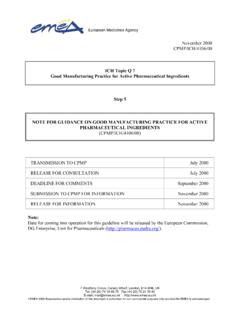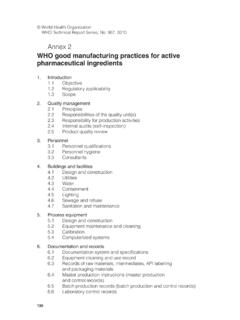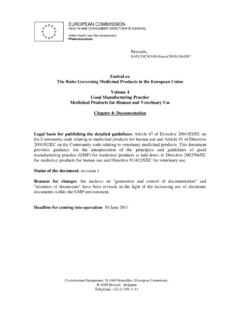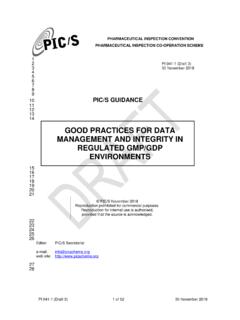Transcription of 2008 11 25 gmp-an1 - European Commission
1 European Commission ENTERPRISE AND INDUSTRY DIRECTORATE-GENERAL Consumer goods Pharmaceuticals Brussels, 25 November 2008 (rev.) EudraLex The Rules Governing medicinal Products in the European Union Volume 4 EU Guidelines to good manufacturing Practice medicinal Products for Human and Veterinary Use annex 1 Manufacture of Sterile medicinal Products (corrected version) Document History Previous version dated 30 May 2003, in operation since September 2003 Revision to align classification table of clean rooms, to include guidance on media simultations, bioburden monitoring and capping of vials November 2005 to December 2007 Date for coming into operation and superseding 01 March 20091 Please note correction on the implementation of provisions for capping of vials!
2 1 Note: Provisions on capping of vials should be implemented by 01 March 2010. Commission Europ enne, B-1049 Bruxelles / Europese Commissie, B-1049 Brussel Belgium. Telephone: (32-2) 299 11 11 2 annex 1 MANUFACTURE OF STERILE medicinal PRODUCTS Principle The manufacture of sterile products is subject to special requirements in order to minimize risks of microbiological contamination, and of particulate and pyrogen contamination. Much depends on the skill, training and attitudes of the personnel involved.
3 Quality Assurance is particularly important, and this type of manufacture must strictly follow carefully established and validated methods of preparation and procedure. Sole reliance for sterility or other quality aspects must not be placed on any terminal process or finished product test. Note: This guidance does not lay down detailed methods for determining the microbiological and particulate cleanliness of air, surfaces etc. Reference should be made to other documents such as the EN/ISO Standards. General 1. The manufacture of sterile products should be carried out in clean areas entry to which should be through airlocks for personnel and/or for equipment and materials.
4 Clean areas should be maintained to an appropriate cleanliness standard and supplied with air which has passed through filters of an appropriate efficiency. 2. The various operations of component preparation, product preparation and filling should be carried out in separate areas within the clean area. manufacturing operations are divided into two categories; firstly those where the product is terminally sterilised, and secondly those which are conducted aseptically at some or all stages. 3. Clean areas for the manufacture of sterile products are classified according to the required characteristics of the environment.
5 Each manufacturing operation requires an appropriate environmental cleanliness level in the operational state in order to minimise the risks of particulate or microbial contamination of the product or materials being handled. In order to meet in operation conditions these areas should be designed to reach certain specified air-cleanliness levels in the at rest occupancy state. The at-rest state is the condition where the installation is installed and operating, complete with production equipment but with no operating personnel present.
6 The in operation state is the condition where the installation is functioning in the defined operating mode with the specified number of personnel working. The in operation and at rest states should be defined for each clean room or suite of clean rooms. For the manufacture of sterile medicinal products 4 grades can be distinguished. Grade A: The local zone for high risk operations, filling zone, stopper bowls, open ampoules and vials, making aseptic connections. Normally such conditions are provided by a laminar air flow work station. Laminar air flow systems should provide a homogeneous air speed in a range of m/s (guidance value) at the working position in open clean room applications.
7 The maintenance of laminarity should be demonstrated and validated. 3 A uni-directional air flow and lower velocities may be used in closed isolators and glove boxes. Grade B: For aseptic preparation and filling, this is the background environment for the grade A zone. Grade C and D: Clean areas for carrying out less critical stages in the manufacture of sterile products. Clean room and clean air device classification 4. Clean rooms and clean air devices should be classified in accordance with EN ISO 14644-1. Classification should be clearly differentiated from operational process environmental monitoring.
8 The maximum permitted airborne particle concentration for each grade is given in the following table. Maximum permitted number of particles per m3 equal to or greater than the tabulated size At rest In operation Grade m m m m A 3 520 20 3 520 20 B 3 520 29 352 000 2 900 C 352 000 2 900 3 520 000 29 000 D 3 520 000 29 000 Not defined Not defined 5. For classification purposes in Grade A zones, a minimum sample volume of 1m3 should be taken per sample location. For Grade A the airborne particle classification is ISO dictated by the limit for particles m.
9 For Grade B (at rest) the airborne particle classification is ISO 5 for both considered particle sizes.. For Grade C (at rest & in operation) the airborne particle classification is ISO 7 and ISO 8 respectively. For Grade D (at rest) the airborne particle classification is ISO 8. For classification purposes EN/ISO 14644-1 methodology defines both the minimum number of sample locations and the sample size based on the class limit of the largest considered particle size and the method of evaluation of the data collected. 6. Portable particle counters with a short length of sample tubing should be used for classification purposes because of the relatively higher rate of precipitation of particles m in remote sampling systems with long lengths of tubing.
10 Isokinetic sample heads shall be used in unidirectional airflow systems. 7. In operation classification may be demonstrated during normal operations, simulated operations or during media fills as worst-case simulation is required for this. EN ISO 14644-2 provides information on testing to demonstrate continued compliance with the assigned cleanliness classifications. Clean room and clean air device monitoring 8. Clean rooms and clean air devices should be routinely monitored in operation and the monitoring locations based on a formal risk analysis study and the results obtained during the classification of rooms and/or clean air devices.

















